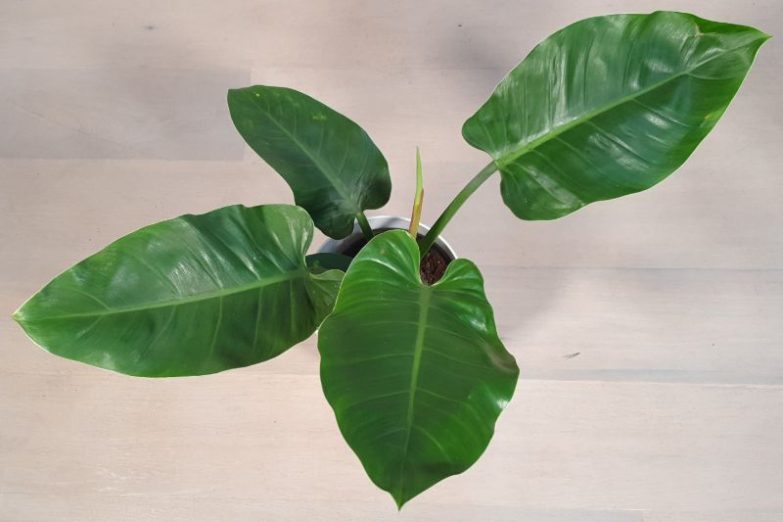Philodendron Imperial Green never fails to draw the eye, with large, stiff, glossy-green leaves that fan out impressively from a central stem. This non-vining philodendron is widely available, inexpensive, and looks fantastic. This article will help you learn everything you need to know about Philodendron Imperial Green care to keep your plant thriving.
Philodendron Imperial Green needs bright, indirect light, well-draining soil, and moderate humidity to thrive. Water once the top half of the soil feels dry, maintain temperatures of 60-85°F(16-30°C), avoid drafts, and fertilize lightly every month during spring and summer.
Read on to learn about every aspect of caring for this plant, as well as how to prevent and deal with some of the most common problems.
Philodendron Imperial Green Overview
Philodendron Imperial Green is a cultivar of Philodendron erubescens, prized for its large, smooth green leaves that fan out in all directions, looking quite spectacular on display.
It is very similar to Philodendron Imperial Red and has exactly the same care requirements. It is also quite similar to Philodendron Prince Of Orange and Philodendron Congo.
Philodendron Imperial Green is a self-heading Philodendron that will stay relatively compact. The leaves are impressive in size but relatively few in number. This is a plant that always draws compliments from anyone who sees it in my home. Not only is this plant a beauty, but it isn’t too hard to keep happy.
Philodendron Imperial Green Care Summary
| Name | Philodendron Imperial Green |
| Origin | Cultivated variety of Philodendron erubescens |
| Light Requirements | Place in bright, indirect light. Direct sunlight can cause leaf damage. |
| Watering | Water once the top half of the soil feels dry. Will not tolerate being overwatered. |
| Soil | Well-draining soil is essential, but it should also have some moisture holding capability. A mix of 50% potting mix and 50% drainage amendments such as coarse sand, perlite, or pumice works well, although a specialist Aroid mix is ideal. |
| Temperature | Philodendron Imperial Green will thrive in temperatures of 60-85°F(16-30°C). Hot and cold drafts can cause leaf damage. |
| Fertilizer | Fertilize every 4 weeks during spring and summer, but err on the side of caution with frequency and strength of the preparation. I use a balanced, water-soluble fertilizer at half strength. |
| Humidity | Will do best in moderate to high humidity of 40-60%, but reasonably tolerant of lower humidity levels due to its glossy leaves. |
| Pruning | Minimal pruning required. Remove dead or damaged leaves as necessary. |
| Propagation | Philodendron Imperial Green can be propagated from stem cuttings in water or soil. It can be tricky to take stem cuttings due to the proximity of the leaves. Commercial plants are produced by tissue culture. |
| Re-Potting | Only needs to be repotted once significantly rootbound. |
| Diseases and Pests | Bacterial blight and bacterial leaf spot can occur in an overwatered or stressed plant. Fairly pest resistant. Check your plant regularly and treat it promptly. |
| Toxicity | Mildly toxic to humans and animals. |
| Where To Buy | Buy Philodendron Imperial Green online at Etsy (I buy most of my houseplants from Etsy). |
Philodendron Imperial Green Light Requirements
Your Philodendron Imperial Green will do best when placed in bright, indirect light. Place it near a window, but avoid direct sunlight, as this will cause scorching of the leaves that will ruin its appearance.
If your plant is in low light conditions it will stop growing and will be at much greater risk of a range of other problems including overwatering. If you do not see your Philodendron Imperial Green producing any new leaves over a period of several months, consider low light as being a likely cause.
It can be difficult to know exactly what bright, indirect light is, but you can read my article that explains light levels for houseplants for more information.
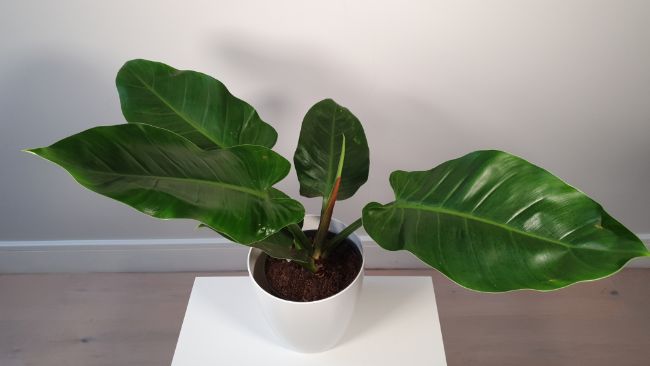
Watering
Watering is the next most important aspect of Philodendron Imperial Green care after lighting, and getting this right is crucial to keeping your plant thriving over time. It is a constant balance to provide enough water to your plant, while still maintaining well-aerated conditions in the soil that your plant needs to thrive.
Water your Philodendron Imperial Green once the top half of the soil feels dry. Stick your finger right into the soil to check how dry it is and also use the weight of the pot to determine how dry the soil is before watering. If you’re struggling to know exactly when to water your plants, I’ve written another article that will help.
Avoid watering Philodendron Imperial Green on a schedule, but check your plant every few days to see if it needs to be watered. If in doubt, leave your plant another day or two, as overwatering is likely to do much more harm than underwatering.
Make sure to thoroughly soak the soil when you do water your plant. I like to add a little water at a time and let it sink in, giving the soil plenty of time to get evenly moist. Keep watering until water flows freely from the drainage holes and the pot feels heavy. Let the pot drain thoroughly after watering.
Top Tip: Make sure the pot has plenty of drainage holes and is an appropriate size for the plant to greatly reduce the risk of overwatering. Make some changes if needed, as trying to fight against unfavorable conditions is an uphill battle.
What Type Of Water Is Best For Philodendron Imperial Green?
Tap water is fine for Philodendron Imperial Green. The leaves aren’t overly sensitive to impurities, fluoride, or chloramines in your water. However, if all other aspects of care are well attended to, but you still see brown leaf tips and edges appearing, you could consider switching to rainwater or distilled water.
Philodendron Imperial Green Soil Requirements
Well-draining soil is essential for a healthy plant. Heavy, poorly draining soil almost always spells disaster, no matter how careful you are.
The aim is to use soil that provides plenty of aeration, but that will also retain some water, to prevent the plant from drying out too quickly.
- 50% houseplant potting mix and 50% perlite or coarse sand.
- 1/3 peat or coco coir, 1/3 orchid mix, and 1/3 perlite or coarse sand.
- A specialist aroid mix is a great option for Philodendron Imperial Green. I buy mine online from Etsy.
Soil can become compacted over time and you may notice it draining increasingly poorly after you water your plant. This may be a good time to repot your plant into a lighter mix, or you could try aerating the existing soil to improve drainage.
Humidity Requirements
Whilst Philodendron Imperial Green is more tolerant of low humidity than many other houseplants, it will still do best when humidity is kept above 40%, and 50-60% is even better.
If humidity is too low, you may see the leaf edges starting to curl, and brown tips and leaf edges may develop. The best way to prevent this is to monitor the humidity levels in your home, and manually adjust them. I use a digital hygrometer to keep an eye on humidity levels for my plants (This is the one I use).
If you do notice that humidity levels are too low, try one of these methods to boost them to a higher level.
- Group your plants together. The increased transpiration and evaporation of water from your plants will improve local humidity levels very nicely.
- Use a humidity tray beside or under your plants. Arrange some small pebbles in a wide dish. Fill it with water to a level just below the top of the pebbles. Place your plant pot on the tray, ensuring that the base of the pot is above the level of the water.
- Move your plant to a more humid room, such as a bathroom, laundry room, or your kitchen.
- Use a humidifier to quickly and easily raise humidity levels. Some models even allow you to set a target humidity level that the machine will try to maintain.
- Check out this article that covers other great ways to increase humidity.
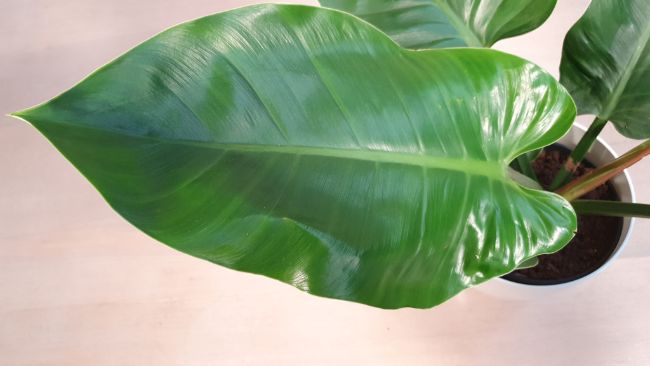
Temperature Requirements
Normal indoor temperatures are perfect for Philodendron Imperial Green, and in fact, anywhere from 60-85°F(16-30°C) will be fine. Your plant will largely stop growing at the lower end of this range, so it’s best to keep the temperature up a little. It will typically stop growing below 60°F (16°C) and can suffer cold damage below 50°F (10°C).
The main temperature problem to watch out for is drafts. Both hot and cold drafts can do considerable damage to a Philodendron Imperial Green, resulting in browning or yellowing leaves. Make sure your plant is not placed near heating or cooling vents, radiators, or drafty windows.
How To Fertilize Philodendron Imperial Green
Fertilizer is a crucial element of growing a healthy Philodendron Imperial Green, but it’s important not to overdo it. I use a balanced (20-20-20) fertilizer that I apply every 4 weeks during spring and summer at half the recommended strength for outdoor plants. Here is a link to the fertilizer I use.
There are many other options for fertilizing your Philodendron Imperial Green. Whilst I use a synthetic fertilizer, there are loads of great organic options. Seaweed extract in particular is an excellent option.
Another choice is to simply add about 10% compost or worm castings to the potting mix when repotting. This normally provides sufficient nutrients for 1-2 years. You can carefully mix a little compost into the soil on an annual basis if your plant doesn’t need to be repotted. Read my guide to fertilizing indoor plants to learn more.
Watch out for any signs of overfertilizing, such as brown leaf tips, a plant that fails to thrive despite being given otherwise good growing conditions, or evidence of fertilizer salt deposits on the soil surface.
Sometimes stopping fertilizing isn’t enough to prevent damage to your plant. Consider one of the following if you think you may have overfertilized your plant;
- Repot your plant into fresh potting mix.
- Flush the existing soil with copious quantities of water. This will help to flush excess fertilzer salts out of the soil.
Either way, hold off fertilzing your plant for at least 6 months to let the plant fully recover. Then resume a more conservative regime.
Pruning
Philodendron Imperial Green care does not involve a lot of pruning. In fact, all you need to do is prune off any dead or damaged leaves as you feel is necessary.
Repotting
If you’d like to maximize the growth of your Philodendron Imperial Green, then repot it once the roots start growing out of the bottom drainage holes. Only increase the pot size by 1-2 inches, as opting for a larger pot greatly increases the risk of overwatering.
Philodendron Imperial Green can cope with being quite rootbound, and it won’t affect the health of the plant, other than mildly restricting growth, as long as its care needs are being met.
If you’d like some pointers on the best way to repot a rootbound plant, this article should help you out.
How To Propagate Philodendron Imperial Green
The best way to propagate a Philodendron Imperial Green is by taking stem cuttings. It’s important that your cuttings contain a node, and if they have any aerial roots, that’s even better.
Juvenile Philodendron Imperial Green plants have a very compact growth habit, and there is often very little room between nodes on the stem. This can make it quite difficult to take stem cuttings. Mature plants tend to stretch a little, making the process of taking cuttings a lot easier.
You can plant your cuttings directly in soil, or root them in water for a few weeks until plenty of healthy roots are being produced. Water propagated cuttings should be transferred to soil once the roots are a few inches long.
I tend to find that water propagating Philodendrons is more predictable and has a higher success rate than planting directly in soil. However, there is a risk of failure when water propagated cuttings are transferred to soil.
Commercially, Philodendron Imperial Green is produced by tissue culture. This is a much faster way of producing large quantities of young plants from a small number of mature plants, but requires specialist equipment and experience.
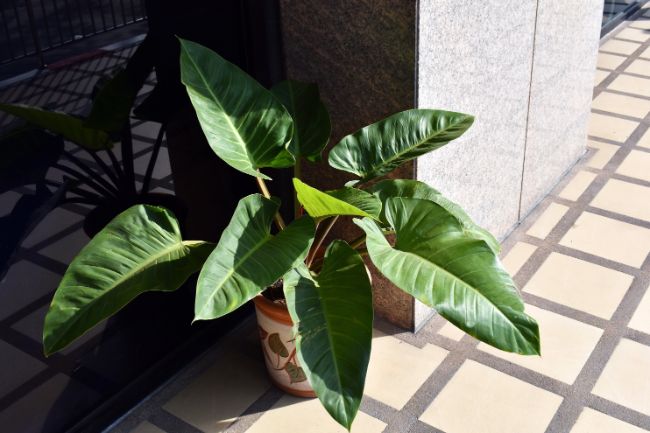
Philodendron Imperial Green Care Tips
- The most likely cause of yellow leaves is overwatering. If your Philodendron Imperial Green starts to get yellow leaves, explore this possibility first.
- Acclimation can lead to some leaf yellowing when you first bring your plant home. This is normal, so just focus on providing good care conditions, and healthy growth should resume.
- Most people underestimate what bright, indirect light is. Try to improve lighting for your plant without exposing it to direct sunlight.
- Root rot is the greatest threat to the health of your Philodendron Imperial Green. Take extra care that your plant needs watered before doing so, and make sure your choice of soil and pot promotes good drainage and aeraton of the roots.
Does Philodendron Imperial Green Climb?
Philodendron Imperial Green is a self-heading, or non-vining variety of philodendron. It will grow with an upright growth habit, unlikely to need staking for several years, but does not readily climb.
Why Is My Philodendron Imperial Green Dying?
The most common cause of a Philodendron Imperial Green dying is root rot. This can be caused by a combination of overwatering, poorly draining soil, wrong size or type of pot, low light, or cool temperatures. Lighting, watering, and choice of soil are crucial factors in keeping your plant healthy.
Why Does My Philodendron Imperial Green Have Yellow Leaves?
Overwatering is the most common cause of yellow leaves on Philodendron Imperial Green. This will normally affect the lower leaves first. It can appear as yellow spots on the leaves, or the entire leaves may turn yellow and then die.
Excess light, acclimation, and cold stress are other common causes of yellow leaves.
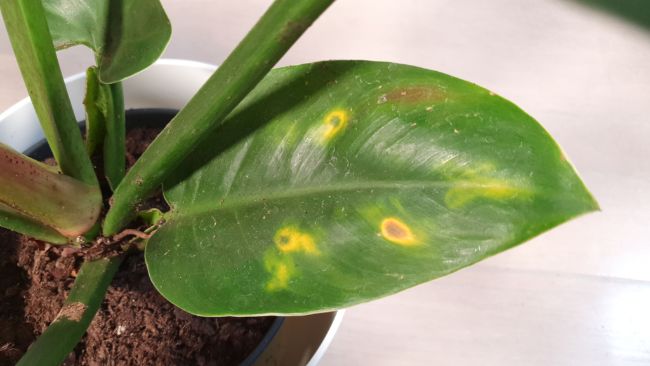
Why Does My Philodendron Imperial Green Have Brown Tips And Leaf Edges?
Brown tips and leaf edges are most likely to be caused by underwatering or low humidity. However, overwatering can also result in brown leaf tips if root rot has set in. Other sources of stress, such as excess fertilizer, drafts, or cold stress can also cause brown tips and leaf edges.
Philodendron Imperial Green Size
Philodendron Imperial green typically grows to a spread of about 3 feet (90cm) and can reach several feet in height at maturity.
Pests
Philodendron Imperial Green is relatively pest-resistant compared to many other houseplants. It can be affected by mealybugs, scale, and spider mites, most commonly. Look for irregular yellow spots or holes in the leaves. You should also be able to see the pests themselves if you inspect your plant closely.
Prevention and prompt intervention are the keys to stopping pests from impacting the health of your plant. Check the leaves, stems and soil of your plant every time you check to see if it needs to be watered.
I normally treat pests in the following way;
- If there are any signs of pests, immediately quarantine your plant from any other plants, to prevent the bugs spreading.
- Manually remove any bugs you can see using a cloth, or wash them off gently using a stream of water.
- Treat the entire plant with either dilute neem oil, horticultural soap or isopropyl alcohol, sprayed all over the foliage.
- Continue to isolate your plant from any others and repeat the treatment at weekly intervals until you are 100% sure all pests have been dealt with.
- Read my guide to identifying, treating, and preventing common houseplant pests for more info.
Diseases
Philodendron Imperial Green is fairly disease resistant unless it is already weakened due to another cause. An overwatered plant is at high risk of developing disease.
Bacterial leaf spot can cause dark, wet-looking spots with yellow halos on the leaves. Bacterial blight can result in rapidly spreading, small dark spots on the leaves. The leaves will quickly collapse and die if left untreated.
If you notice evidence of disease on your Philodendron Imperial Green, you should isolate it from any other houseplants and then carefully prune off all affected foliage with sterile pruning shears.
Make sure that all other aspects of Philodendron Imperial Green care are being met, to ensure your plant is not at excessive risk of further disease. It will likely take at least several months for your plant to recover from disease, and ensuring good care conditions will help greatly with the recovery.
Aside from keeping your plant generally healthy, it is crucial to check your plant regularly and respond to any signs of disease quickly. Advanced symptoms will usually result in the death of your plant.
Toxicity
Philodendron Imperial Green is mildly toxic to humans and pets if ingested, and can result in gastrointestinal upset. It may also cause a localized skin reaction, so you may wish to wear gloves if you are handling or pruning it.
Last Word
I hope I’ve covered all your questions about Philodendron Imperial Green Care. Many of the same care principles will apply to other non-vining Philodendrons. If you’re having difficulties keeping your plant in good health, take your time to go through each aspect of care and you should soon identify why your plant is not so happy.
If you’d like to read more about caring for philoendrons, you can check out some of my other articles below.

